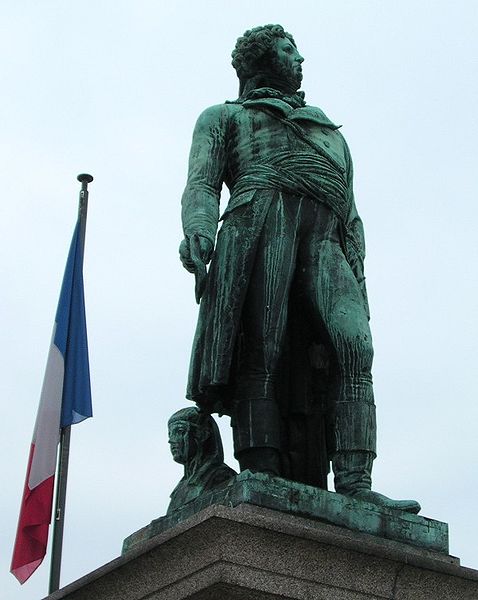The Strange Afterlife of Jean-Baptiste Kléber
Now that all the interesting teams have been eliminated, and the usual teams are moving on in the World Cup, I can look forward to the Tour de France. It’s one of the few broadcasted sports not played in an artificial environment (stadium or arena) in which the participants encounter the landscapes of the country. Indeed, the Tour de France was created in 1903 as an event that would cover the entirety of France, making the public think of how expansive, yet united, the country was.
Last year, just before I returned from France, banners appeared around the Place Kléber announcing that Strasbourg would be the starting point for the 2006 race. Twice before Strasbourg has been the Grand Départ, first in 1919, when Alsace was returned to France by the Treaty of Versailles, then in 1952 to promote the coming of the European Parliament–two moments of major historical and political importance. Even so, almost every race has had one through Alsace. The Tour has always had a message: Alsace belongs to France, and France belongs in Alsace.
The site of the Grand Départ is the Place Kléber (Google satellite map), the largest square at the center of the city. Along withe the Cathedral, it is one of two centers of public life in both Strasbourg and Alsace. Towering above the landscape, the Cathedral was a symbol of Gothic style and Christian democracy. Clemenceau chose it to celebrate Alsace’s return, but secular France did not embrace it.
The Place Kléber, perhaps not even a quarter mile from the Cathedral, is at the heart of the city's commercial area. Known originally as the Aubette (a northern French word for market) and the Barfüsserplatz ("barefoot square"--a Franciscan monastery was once nearby), it is the largest open space within the medieval city. The market stalls still stand along the northern side, and the major shopping avenues radiated from it in all directions. People congregate there at all hours of the day.
Overlooking the square is the statue of Jean-Baptiste Kléber (1753-1800), Napoleon’s general. It was he who fought against the Ottomans in Egypt when Napoleon returned to France. Immediately, the Strasbourgeoisie celebrated him as their hero of the Revolutionary Era.

Plans to memorialize Kléber emerged almost immediately: during the brief restoration that preceded the One Hundred Days. Municipal officials insisted that it was a matter of honoring an example of bravery than preserving sentiment for the Empire, but the royal prefect, Bouthillier, regarded Strasbourg as hostile territory to the Bourbon Monarchy: “among the people one often cries vive l'Empereur! I must make continual arrests.” In 1818 the ministers of war and interior recommended that the statue should not be on public ground; the appropriate space for it would be the Cathedral (where Kléber’s body had been reinterred.) (Perhaps they were right to be concerned: in 1836, Louis Napoleon was able to win over some of the citizens and officers in his brief coup.) The statue, designed by Philippe Grass, was finally completed in 1838, and Kléber's corpse was reburried underneath it.
The monument took on more nationalist meaning after the German annexation. The pro-French student clubs at the university made it the site of its most important rituals, the monôme. According to John Craig,
“following the annual banquet members [of the clubs] marched silently and in single file to the city's central square, there to pay their respect to the statue of Jean-Baptiste Kléber.”The ritual came to an end when the student clubs were outlawed and disbanded.
In 1905, the Kléber monument again became a site of tension between region and the German Empire. A group of alumni, many of whom had moved to France, repeated the monôme. The police, acting on instinct rather than orders, dispersed them. The press was livid: another incident in which Germans rejected Alsatians as equal citizens. Editorials focused on Kléber’s Germanness–his family’s origins in Franconia, his education at a Bavarian military academy, and his service in the Austrian military. However, some editorials focused on Kléber’s Alsatian-ness: he belonged to Alsace, and if Germany wanted Alsace, they had to accept Kléber. According to one letter, written in Kléber’s voice,
“Alsatian I was, and Alsatian I remain.”German authorities had no choice but to tolerate Kléber, his monument, and the veneration of the Strasbourgeoisie. They must naturalize him.
The letter echoed the sentiment of societies that remembered the military accomplishments of Alsatians ... for France, of course. German culture made the memory of fallen soldiers one of the highest civic duties. The Alsatian memorial societies claimed to do only that:
“The memory of the dead is a harvester of the past that brings out of the recesses of the heart that which is best in our history.”Of course, it forced a confrontation between Alsace’s history and German nationalism. It was the origin of an understanding of indigenous rights that would be fully developed in the 1930s: Alsatians had the right to remain what they were. Any ambitions that they had to become more must proceed from their right.
When the Germans returned in 1940, the statue was dismantled, and Kléber was reburied elsewhere. The square was renamed Karl Roos Platz, after an automist who was shot in 1940 by the French government. With the defeat of Germany, the square was renamed, and Kléber, both corpse and statue, were returned.
The Place Kléber and its venerated hero was always the site of contested nationality, but always a nationality that had special local and regional meaning: borne of citizenship rather than ethnicity. The memory of Jean-Baptiste Kléber exceeded, perhaps, his own deeds. He became the eternal citizen of Alsace, a reminder to the nation of the genius and self-determination of the people.





0 Comments:
Post a Comment
<< Home